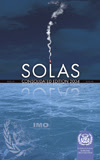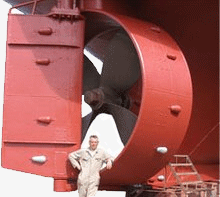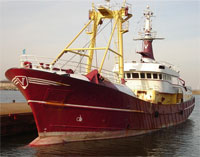We have moved!
This blog is hosted on a free service by Blogspot.com. Nice to get started but it lacked the flexibility I needed so we moved it to our own server and run it under a more flexible blog software called WordPress.
Please visit www.expeditionyacht.org from now on.
All content has been moved over there as well.
Thanks.
Thorwald Westmaas
blogger/project engineer
Friday, April 13, 2007
Thursday, April 12, 2007
Fire protection
 I said it before, where would I be without the Internet? Here we are in Panama, while a maritime hub, not exactly the center of maritime technology. The Panama Canal, while impressive and very smartly designed is over 90 years old and that's about the last time anything big happened on the local maritime scene.
I said it before, where would I be without the Internet? Here we are in Panama, while a maritime hub, not exactly the center of maritime technology. The Panama Canal, while impressive and very smartly designed is over 90 years old and that's about the last time anything big happened on the local maritime scene.So, getting info on what we need to make our project happen involves many hours of Internet surfing.
While surfing, I learned I would need a sprinker system in the guest accommodations. I had hoped to use the FirePro system but is not allowed for use in accommodation spaces as it creates a fine white mist which would not help guests to find their way to the exit in case of a fire. Too bad! It's a great concept (see other article in this section). But sprinklers make everything very wet. Many times, they do more damage than the fire itself! But, so I learned, there's an alternative. Water mist systems. They use about 70% less water, work more efficient, assure less smoke damage, require smaller piping and are environmentally friend: they use water after all.
 So far I've found only two companies that manufactures these systems. A finish one, Marioff, seems to be the major manufacturer and they have a very informative website. Check out Marioff's Hi-Fog system. Can you believe they even offer gold-plated sprinklers, especially made for use in mega yachts?
So far I've found only two companies that manufactures these systems. A finish one, Marioff, seems to be the major manufacturer and they have a very informative website. Check out Marioff's Hi-Fog system. Can you believe they even offer gold-plated sprinklers, especially made for use in mega yachts?A US-company, Fike Corporation also has a water mist fire protection system but I'm not sure yet if it meets class requirements. While they seem to serve the marine industry, there's no referral to type approval of their micro mist system.
And I ran into a German company, Fogtec that also manufactures water mist applications for marine use. Also a very informative site. Do check out their water mist history section. You can even watch videos of their product in operation! Those guys know how to use the Internet to inform their prospective clients. Sehr gut !
The following links also provide useful information about the history and use of water mist systems:
- water mist fire systems for shipboard use
(somewhat dated but very informative with comparativeinfo) - High pressure water mist fire protection off-shore
- Water mist: old method, new technology
 My only concern so far is that these systems are expensive or so I am told. At least they look expensive :-). But remember, we're not using the gold-plated ones.
My only concern so far is that these systems are expensive or so I am told. At least they look expensive :-). But remember, we're not using the gold-plated ones.
I wonder if there are alternatives for passenger spaces that are also SOLAS approved. Still surfing and e-mailing to find that out.
Drawings outsourced to China
Our ship was built in 1989, before the time every shipyard used software to create technical drawing. Luckily the design of our vessel hasn't changed over the  years to our ship's designer, Herman Jansen BV in the Netherland had AutoCAD drawing of newer ships that used the same hull.
years to our ship's designer, Herman Jansen BV in the Netherland had AutoCAD drawing of newer ships that used the same hull.
However, the inside of the vessel like engine room, piping diagrams, and lots and lots of details were not available in AutoCAD. So, we just contracted a Chinese company to convert the most important of these drawings into AutoCAD to help us with the conversion and be able to provide precise and updated plans to meet future regulatory compliance.
Where would we be without the Internet ? Thanks Al Gore ! :-)
 years to our ship's designer, Herman Jansen BV in the Netherland had AutoCAD drawing of newer ships that used the same hull.
years to our ship's designer, Herman Jansen BV in the Netherland had AutoCAD drawing of newer ships that used the same hull.However, the inside of the vessel like engine room, piping diagrams, and lots and lots of details were not available in AutoCAD. So, we just contracted a Chinese company to convert the most important of these drawings into AutoCAD to help us with the conversion and be able to provide precise and updated plans to meet future regulatory compliance.
Where would we be without the Internet ? Thanks Al Gore ! :-)
Classification & SOLAS
As our ideas on how to change the vessel in a private expedition yacht converted into more detailed drawings, it became time to decide under which rules we plan to do do the conversion. Class requirements and international conventions have an important impact on the building requirements such as the use of approved materials, installation of watertight doors, life saving equipment and fire detection equipment.
 You will see a lot of yachts, even the very big ones (check out yachtworld.com), have space for only 12 guests. This is not done because the owner has few friends to take along. It's done to avoid more stringent safety requirements. Once a vessel makes an international voyage with more than 12 passengers, it becomes subject to SOLAS regulation and is considered a passenger vessel even if it is in use as a private yacht. The SOLAS Convention in its successive forms is generally regarded as the most important of all international treaties concerning the safety of merchant ships. The first version was adopted in 1914, in response to the Titanic disaster, the second in 1929, the third in 1948, and the fourth in 1960.
You will see a lot of yachts, even the very big ones (check out yachtworld.com), have space for only 12 guests. This is not done because the owner has few friends to take along. It's done to avoid more stringent safety requirements. Once a vessel makes an international voyage with more than 12 passengers, it becomes subject to SOLAS regulation and is considered a passenger vessel even if it is in use as a private yacht. The SOLAS Convention in its successive forms is generally regarded as the most important of all international treaties concerning the safety of merchant ships. The first version was adopted in 1914, in response to the Titanic disaster, the second in 1929, the third in 1948, and the fourth in 1960.
Passenger vessels are subject to very extensive safety regulations in regards to fire safety, navigation equipment, live saving equipment and more.
When we started asking around, many people recommended us not to design for more than 12 passengers because of the extra cost involved with regulatory compliance. But with several owners, we felt that 12 passengers isn't very much and this limitation would limited the usability of our yacht considerably (and its resale value :-) ). Moreover, when we started to look into the SOLAS requirements, it turned out that they were very much common sense and something we'd like to build into our yacht regardless of the requirements.
 For instance, what's wrong with using fire-resistant walls between cabins and have a fire detection and protecion system that works automatically and uses an environmentally friendly product? Or use enough watertight doors so hitting the rocks won't sink the ship? Or have enough live vests and life rafts on each side of the ship with a release system that even grandma can use?
For instance, what's wrong with using fire-resistant walls between cabins and have a fire detection and protecion system that works automatically and uses an environmentally friendly product? Or use enough watertight doors so hitting the rocks won't sink the ship? Or have enough live vests and life rafts on each side of the ship with a release system that even grandma can use?
So, we'll just stick to SOLAS and be safe! I'd hard to understand why anybody spending a few million on a serious yacht would not make the extra investment in safety but I guess they haven't heard the line 'if you think safety is expensive, try an accident'.
SOLAS compliance is enfored by the flag state, in our case it will be Panama. We plan to hire ABS (American Bureau of Shipping) to review and approve all our plans to make sure we meet SOLAS requirements and conduct the actual survey.
 You will see a lot of yachts, even the very big ones (check out yachtworld.com), have space for only 12 guests. This is not done because the owner has few friends to take along. It's done to avoid more stringent safety requirements. Once a vessel makes an international voyage with more than 12 passengers, it becomes subject to SOLAS regulation and is considered a passenger vessel even if it is in use as a private yacht. The SOLAS Convention in its successive forms is generally regarded as the most important of all international treaties concerning the safety of merchant ships. The first version was adopted in 1914, in response to the Titanic disaster, the second in 1929, the third in 1948, and the fourth in 1960.
You will see a lot of yachts, even the very big ones (check out yachtworld.com), have space for only 12 guests. This is not done because the owner has few friends to take along. It's done to avoid more stringent safety requirements. Once a vessel makes an international voyage with more than 12 passengers, it becomes subject to SOLAS regulation and is considered a passenger vessel even if it is in use as a private yacht. The SOLAS Convention in its successive forms is generally regarded as the most important of all international treaties concerning the safety of merchant ships. The first version was adopted in 1914, in response to the Titanic disaster, the second in 1929, the third in 1948, and the fourth in 1960.Passenger vessels are subject to very extensive safety regulations in regards to fire safety, navigation equipment, live saving equipment and more.
When we started asking around, many people recommended us not to design for more than 12 passengers because of the extra cost involved with regulatory compliance. But with several owners, we felt that 12 passengers isn't very much and this limitation would limited the usability of our yacht considerably (and its resale value :-) ). Moreover, when we started to look into the SOLAS requirements, it turned out that they were very much common sense and something we'd like to build into our yacht regardless of the requirements.
 For instance, what's wrong with using fire-resistant walls between cabins and have a fire detection and protecion system that works automatically and uses an environmentally friendly product? Or use enough watertight doors so hitting the rocks won't sink the ship? Or have enough live vests and life rafts on each side of the ship with a release system that even grandma can use?
For instance, what's wrong with using fire-resistant walls between cabins and have a fire detection and protecion system that works automatically and uses an environmentally friendly product? Or use enough watertight doors so hitting the rocks won't sink the ship? Or have enough live vests and life rafts on each side of the ship with a release system that even grandma can use?So, we'll just stick to SOLAS and be safe! I'd hard to understand why anybody spending a few million on a serious yacht would not make the extra investment in safety but I guess they haven't heard the line 'if you think safety is expensive, try an accident'.
SOLAS compliance is enfored by the flag state, in our case it will be Panama. We plan to hire ABS (American Bureau of Shipping) to review and approve all our plans to make sure we meet SOLAS requirements and conduct the actual survey.
Tuesday, March 13, 2007
Latest drawings
 An update of the drawings. The new crane - should I say beam with hoist? - is now further developed. No more (expensive) hydraulic crane. It also matches the general look a lot better.
An update of the drawings. The new crane - should I say beam with hoist? - is now further developed. No more (expensive) hydraulic crane. It also matches the general look a lot better.We also put a little observation platform in front of the mast, taking advantage of the support struts placed in front of it. It accommodates about 7 people. Great for whale watching.
The tenders are place on the aft deck and the access to this deck has been moved. They stick out a little bit but that's OK. We probably need a small hydraulic crane for the tenders but we're still looking at option here.
We also did a litte work on the hold below the staterooms. We put the SCUBA air compressors here and an emergency gen. set but I want to move the air compressors to the engine room and the gen. set to the anchor winch room.
This is a PDF file with a side view. This file has top views.
Slowly but surely it's coming together.
The tenders are place on the aft deck and the access to this deck has been moved. They stick out a little bit but that's OK. We probably need a small hydraulic crane for the tenders but we're still looking at option here.
We also did a litte work on the hold below the staterooms. We put the SCUBA air compressors here and an emergency gen. set but I want to move the air compressors to the engine room and the gen. set to the anchor winch room.
This is a PDF file with a side view. This file has top views.
Slowly but surely it's coming together.
Friday, March 9, 2007
Message board
Thursday, March 8, 2007
Tender design & engine
 We like diving and as a true expedition vessel, we'll be set up for serious diving. We'll also go with aluminium tenders. They simply last longer, give us more design choices and are more affordable then fancy looking RIBS.
We like diving and as a true expedition vessel, we'll be set up for serious diving. We'll also go with aluminium tenders. They simply last longer, give us more design choices and are more affordable then fancy looking RIBS.This is our aluminium dive tender, a Van Vossen Engineering design. Rugged, built-to-last and with some very unique extras to make boarding a piece of cake.
We plan a 235 HP Yanmar engine with a stern drive. While doing our reseach we ran into some folks in Auckland, New Zealand, a company called Q-SPD International. It's a so-called surface drive.

Supposedly it would bring less maintainance than a stern drive, more speed, less vibration thanks to its Python drive (another Dutch design).
More information on surface drives can be found at this site, also from New Zealand. How come those Kiwi's are so into surface drives?
After several days of waiting for the manufacturer to get back to me on this promising alternative we learned these drive or not very effective at low speeds so we plan to stay away from them. But, for informational purposes, we share the sites we found while surfing the Internet to learn more about 'surface drive' principles. We came accross another manufacturer, Levi Drives. Their page on design issues is informative and worth reading. And here' another list of surface drive manufacturers we ran into. In the US you will find Arneson Industries. The image below, comparing propulsion systems, is theirs. Pulse Drive Systems Intn'l is another company from the US.



Subscribe to:
Comments (Atom)

